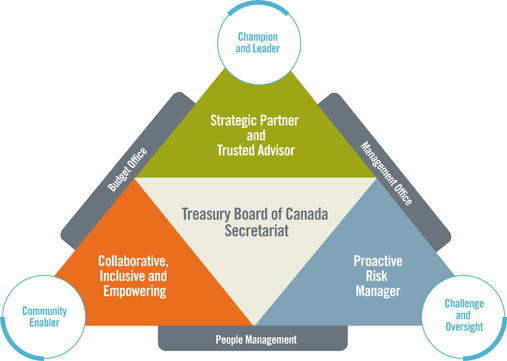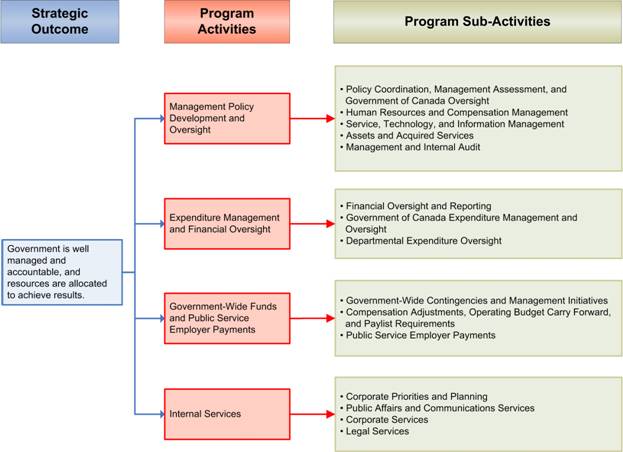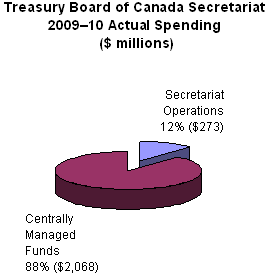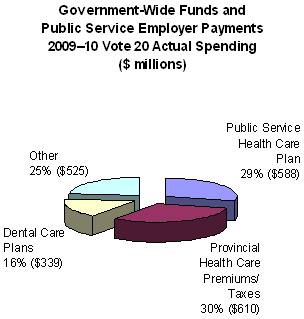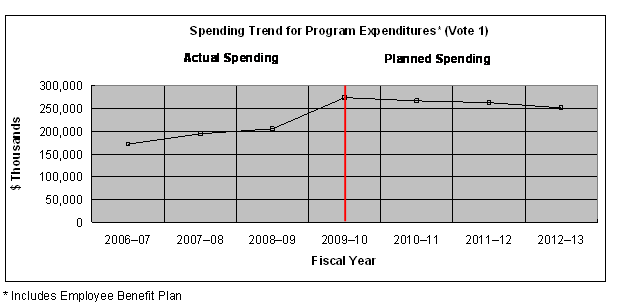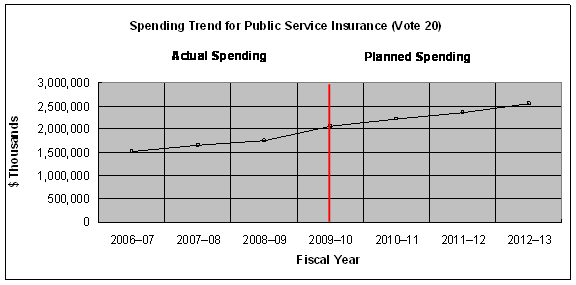Common menu bar links
Breadcrumb Trail
ARCHIVED - Treasury Board of Canada Secretariat - Report
 This page has been archived.
This page has been archived.
Archived Content
Information identified as archived on the Web is for reference, research or recordkeeping purposes. It has not been altered or updated after the date of archiving. Web pages that are archived on the Web are not subject to the Government of Canada Web Standards. As per the Communications Policy of the Government of Canada, you can request alternate formats on the "Contact Us" page.
President's Message
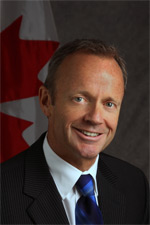
I am pleased to present the 2009–10 Departmental Performance Report of the Treasury Board of Canada Secretariat.
Canadians can take pride in their country's strong economic and fiscal performance—a performance that is anchored in the policies our government adopted in response to the global recession. Throughout this difficult period, the Secretariat has played a vital role, particularly by enabling the implementation of Canada's Economic Action Plan, one of the most comprehensive stimulus packages in the industrialized world.
The economy remains our number-one priority. We are focused on completing the Economic Action Plan and on balancing the budget. We have a clear, three-point plan to contain the costs of the Government of Canada, including a freeze on the operating budgets of federal organizations and the ongoing strategic reviews of departmental spending. These measures, among other targeted reductions, will help us return to a balanced budget by 2014–15.
We have also taken action to further strengthen accountability and transparency in government. For example, starting in fiscal year 2011–12, federal departments and Crown corporations will publish quarterly financial reports, ensuring that parliamentarians and Canadians benefit from enhanced information on government spending.
Finally, our government has continued to reduce unnecessary internal red tape. Through smart rules and reporting, much has been done to simplify the decision-making process to ensure the delivery of timely services to Canadians.
I invite all Canadians to read this report to see the progress we are making in ensuring their tax dollars are spent wisely, prudently and fairly.
The Honourable Stockwell Day, P.C., M.P.
President of the Treasury Board
Section I – Departmental Overview
Raison d’être
The Treasury Board of Canada Secretariat (the Secretariat) is the administrative arm of the Treasury Board. It supports Treasury Board ministers and strengthens the way government is managed to better serve Canadians and ensure value for money in government spending.
Responsibilities
The Treasury Board is a Cabinet committee of ministers invested with a broad range of responsibilities for management excellence, policy development, and budget oversight. As general manager of the public service, the Treasury Board's three main roles are as follows:
- It is the government's management board, responsible for promoting improvement in management performance, developing policies and priorities to manage government assets and resources, and overseeing the government's regulatory function.
- It is the government's budget office, responsible for examining and approving the proposed spending plans of government departments and agencies and for financial management and reporting.
- It is responsible for people management and is the employer of the core public administration.
The Secretariat together with the Canada School of Public Service, the Office of the Commissioner of Lobbying of Canada, and the Office of the Public Sector Integrity Commissioner of Canada form the Treasury Board Portfolio.
The Secretariat makes recommendations and supports the Treasury Board in each of its roles by providing advice on policies, directives, regulations, and program spending that promotes sound management of government resources. The Secretariat also provides leadership and guidance on management functions within departments and agencies, while respecting the primary responsibility of deputy heads in managing their organizations and their role as accounting officers.
Within the Secretariat, the Comptroller General of Canada provides government-wide direction, leadership, and capacity building for financial management, internal audit, and assets management. The Chief Human Resources Officer supports people management across the public service, including the management of labour relations, compensation, pensions and benefits, and workplace policies. The Chief Information Officer provides strategic direction and leadership for the government-wide pursuit of excellence in information management (IM) and information technology (IT).
When working with federal departments, agencies, and Crown corporations, the Secretariat focuses on three central roles:
- An enabling role to help organizations improve management performance;
- An oversight role that includes setting policy and standards and reporting on the government's overall management and budgetary performance; and
- A leadership role in driving and modelling excellence in public sector management.
The following diagram depicts how the Secretariat fulfills these three roles and how it supports the Treasury Board.
The Secretariat's Change Agenda
Established in 2007, the Change Agenda was launched to respond to the changing public service context and the move toward a more risk-sensitive and focused management approach. The purpose of the Change Agenda was to reinforce the Secretariat's role as an enabler of federal leaders and organizations in their achievement of management excellence. The Secretariat and its employees at all levels act as strategic partners, trusted advisors, and proactive risk managers and are collaborative, inclusive, and empowering.
Secretariat functions have a direct impact on the capacity and quality of federal public service management, and on how efficiently and effectively government programs and services are delivered. Through legislation, including the Federal Accountability Act, and changes to Treasury Board policies, deputy heads have clear accountability for departmental and agency resources. The role of the Secretariat is evolving to enable deputy heads to take advantage of their management flexibilities in a way that optimizes performance.
Operating environment
The 2009–10 fiscal year was marked by a worldwide economic downturn. The Government of Canada responded in Budget 2009 by proposing a two-year Economic Action Plan (EAP) to provide immediate economic stimulus while promoting long-term growth. The need to deliver economic stimulus created a unique challenge for government and for the Secretariat. Successful delivery of the first year of the EAP helped Canada to be one of the leading countries in economic recovery. By the end of the year, this strength allowed the government to turn its attention to fiscal restraint in order to address the budgetary deficit.
H1N1 Pandemic Response
The Government of Canada established a coordinated national response to the H1N1 pandemic in cooperation with other levels of government. In its role as employer, the Secretariat provided pandemic-related advice to departments and agencies on employee-related issues and coordinated communications with public sector employees.
At the same time as global economic challenges affected Canadians and the government, demographic and technological shifts continued to be reflected in the public service. Workplace renewal continued to require emphasis on collaboration, technology, innovation, back-office systems, and knowledge management. The public service also continued to face significant recruitment and retention challenges at all levels due to the high number of retirements and the increased mobility of employees across departments.
In addition to addressing these challenges in 2009–10, the government coordinated Canada's response to the H1N1 pandemic and provided Canadians as well as public sector employees with advice (see text box "H1N1 Pandemic Response").
Risk analysis
The Corporate Risk Profile is developed each year as a key part of the Secretariat's integrated risk management practice. An important decision-making tool, it provides information on the potential risks confronting the Secretariat and the appropriate responses to them.
Nine corporate risks were identified for 2009–10 and aligned with program activities. Two of these risks were discussed in the 2009–10 Report on Plans and Priorities (RPP). The first concerned the risk of not having the appropriate financial capacity to achieve expected outcomes. In response, the Secretariat strengthened resource allocation through integrated business planning. The second risk concerned the Secretariat not having sufficient qualified personnel to meet its objectives. This risk was driven by demographic shifts such as the expected high level of senior personnel retiring from the public service. A number of measures were implemented to effectively mitigate this risk, including developing a longer-term Human Resources Plan, a robust Recruitment and Staffing Strategy, and an organization-wide Learning Strategy in support of employee development.
The Secretariat faced two significant challenges during the fiscal year—implementing the stimulus measures of Budget 2009: Canada's Economic Action Plan and completing two organizational transitions. These challenges impacted the workload in program activities 1 and 4: Management Policy Development and Oversight and Internal Services. The challenges associated with implementing Budget 2009 were successfully mitigated by building on previous knowledge of departments and agencies. A risk-based approach supported the expedited approval of Treasury Board submissions while ensuring that due diligence was maintained.
Organizational Change
2009–10 was a year of organizational transition and consolidation for the Secretariat. The creation of the Office of the Chief Human Resources Officer brought together the former Canada Public Service Agency and key parts of the Secretariat that deal with pensions and benefits, labour relations, and compensation in order to streamline people management across the public service. In addition, corporate services functions previously under the Department of Finance Canada were integrated into the Secretariat.
The Secretariat was also largely successful in mitigating the risks associated with implementing the transition of corporate services and the merger of the Canada Public Service Agency (CPSA) (see the text box "Organizational Change"). However, as can be expected with large organizational changes, some targets were not fully met during the year. Further detail is provided in Section II under "Lessons learned: Policy suite renewal—people management." To support the transitions, the Secretariat implemented mitigation strategies, such as developing service agreements, prioritizing work and restructuring workloads to relieve some of the burden, and staffing critical positions.
The Secretariat made significant progress in documenting the integrated risk management process and improving results. This was accomplished by applying lessons learned and working in consultation with the departmental audit committee.
The year in review
Economic Action Plan
Canada's EAP provided a unique opportunity for the Secretariat. Considerable effort was needed to speed the flow of information and advice to ministers to support timely funding approval for EAP initiatives, while showing due diligence and respecting policy requirements. In response to the need to accelerate the implementation process, 85 per cent of the EAP submissions to be considered by the Treasury Board were prepared within 5 months.
Enabling role
This work was successful because the Secretariat was able to appropriately leverage risk-based approaches and knowledge about departments and agencies to expedite the approval process in extraordinary circumstances. It also demonstrated the benefits and value of the Secretariat adopting an enabler role in its relationship with departments and agencies (as presented in the Change Agenda diagram), which reflects an important change. The benefits of the enabler role were further demonstrated in the provision of expert advice and guidance to departments and agencies through the Centre of Expertise on Grant and Contribution Programs, the Centre of Expertise on Risk Management, and the Centre for Regulatory Expertise.
Expenditure and financial management initiatives
In Budget 2010, the government laid out measures to return to balanced budgets and, consequently, to contain departmental growth and reduce spending. In 2009–10, the Secretariat made significant progress on a number of expenditure and financial management initiatives that will support the government over the next few years. For example, the Secretariat completed the third round of strategic reviews. Strategic reviews assess whether programs in an organization are effectively managed, are achieving their intended results, and are appropriately aligned with federal responsibilities and the priorities of Canadians. Reallocation of savings, identified by 12 of the organizations that undertook a review in 2009, were $151.7 million for 2010–11, $247.5 million for 2011–12, and $286.9 million for 2012–13, as announced in Budget 2010. Since 2007, strategic reviews have identified annual ongoing savings of $1.3 billion.
The Secretariat also successfully concluded its review and launch of the government's core financial management policies following approval of the new Policy on Financial Resource Management, Information and Reporting. These new tools will lead to increased transparency through departmental quarterly reporting, starting in 2011.
People management
In 2009–10, the Secretariat strengthened people management by developing policies, gathering information and analysis on the health of the public service, and creating tools and services to support deputy ministers, such as the People Management Dashboard. In addition, the Secretariat increased central agency and departmental capacity in leadership development and talent management. It also ensured that public service compensation was aligned to the Policy Framework for the Management of Compensation and modernized the delivery of benefits programs.
Streamlining
Efforts were expanded to reduce red tape within government. The Secretariat engaged 39 large departments and agencies in developing some 100 initiatives to improve the efficiency of their operations as part of the "web of rules" action plan. The Management Accountability Framework (MAF) was streamlined through a risk-based approach in order to assess some areas of management on a rotational basis. This had the added benefit of reducing the reporting burden on departments and agencies, while keeping the focus on strengthening core areas of management.
Knowledge management
Recognizing the importance of knowledge management, the Secretariat continues to advance the IM Strategy, and promote and support collaborative social media tools for interdepartmental information sharing. The Secretariat created a Government of Canada Executive Project Oversight Committee for large IT-enabled projects, which will brief Treasury Board twice a year. Work also continued to streamline IM and IT policies.
Challenges
While the Secretariat made significant progress in advancing its priorities, work remains to fully complete some initiatives. For example, as a result of ambitious efforts in a number of people management– related areas, the Secretariat needed to revise its target date to complete the renewal of human resources policies. Similarly, while 81 per cent of departments and agencies now have a Management, Resources and Results Structure (MRRS) that meets government standards, there is a need to further strengthen the quality of performance information used by these organizations to measure program success. The Secretariat will continue to work with departments and agencies to enable them to meet enhanced standards under the government-wide Policy on Evaluation.
This Departmental Performance Report (DPR) identifies many of the initiatives and results achieved by the Secretariat during 2009–10. Additional information is provided through links to reference documents, including the 2009–10 RPP upon which this DPR is based.
Strategic outcome and the 2009–10 Program Activity Architecture
The following diagram illustrates the strategic outcome, program activities, and program sub-activities that make up the Secretariat's Program Activity Architecture (PAA). The PAA represents the core programs and results that contribute to achieving the Secretariat's strategic outcome. The Secretariat has revised its PAA for 2010–11 to reflect its new, comprehensive role in people management. Changes have been highlighted in the 2010–11 RPP. For this DPR, however, the Secretariat's report is based on the 2009–10 PAA.
Performance Summary
The following tables provide a summary of total Secretariat resources for 2009–10.
| Planned Spending | Total Authorities | Actual Spending |
|---|---|---|
| 2,315,228 | 4,554,833 | 2,341,557 |
The Secretariat spent approximately $2.3 billion in 2009–10. Most of the variance between planned spending, total authorities, and actual spending can be attributed to the requirement to report the central government-wide funds of $2.1 billion that remained unallocated at year-end under total authorities. Planned spending and actual spending reflect the portion of these authorities planned for and used by the Secretariat for its operations during the year, which include Vote 1 and Vote 20. (For more details, refer to the "Expenditure profile" section.)
| Planned | Actual | Difference |
|---|---|---|
| 1,714 | 2,179 | 465 |
Actual full-time equivalents (FTEs) exceeded planned FTEs mainly due to the amalgamation of the CPSA with the Secretariat following the 2008–09 Human Resources Horizontal Strategic Review. Approximately 380 FTEs from the CPSA merged with the Secretariat during 2009–10. The rest of the difference relates to new initiatives, including the implementation of the Public Sector Equitable Compensation Act and the transfer of employees from the Department of Finance Canada for the provision of corporate services.
2009–10 Performance Summary of Strategic Outcome
| Performance Indicators | Targets | 2009–2010 Performance |
|---|---|---|
| Reports from the Office of the Auditor General and international organizations, the Secretariat's internal audits and evaluations, and MAF findings will provide an indication of the Secretariat's overall progress in the areas of financial and people management. | The Government of Canada is recognized as a world leader in public sector management. |
The Government of Canada is recognized as a world leader in public sector management. Bertelsmann's Sustainable Governance Indicators 2009 ranks Canada third of 30 Organisation for Economic Co-operation and Development (OECD) countries for strategic capacity and fourth for organizational reform capacity. The World Bank's Governance Matters 2009: Worldwide Governance Indicators, 1996-2008 ranks Canada in the 97th percentile for government effectiveness. The MAF five-year evaluation and a detailed analysis of MAF Round VI results demonstrated overall progress in the areas of financial and human resources management, as indicated by an upward trend in the overall MAF scores of departments and agencies in the majority of areas of management. There has been a continuous improvement in MAF results (19%) since 2006–07. |
2009–10 Performance Summary Table: Financial Data by Program Activity ($ thousands)
| Program Activity | 2008–09 Actual Spending |
2009–10 | Alignment to Government of Canada Outcomes | |||
|---|---|---|---|---|---|---|
| Main Estimates |
Planned Spending |
Total Authorities |
Actual Spending |
|||
| 1. Management Policy Development and Oversight | 153,568 | 99,349 | 112,497 | 157,585 | 146,845 | Government Affairs |
| 2. Expenditure Management and Financial Oversight | 51,491 | 36,615 | 37,027 | 43,464 | 37,081 | |
| 3. Government-Wide Funds and Public Service Employer Payments | 1,754,566 | 7,559,700 | 2,103,064 | 4,259,474 | 2,068,107 | |
| 4. Internal Services | 61,513 | 62,640 | 94,310 | 89,524 | ||
| Total | 1,959,625 | 7,757,177 | 2,315,228 | 4,554,833 | 2,341,557 | |
This table provides a performance summary of all four program activities for 2009–10. Commencing in the 2009–10 Estimates cycle, the resources for Internal Services (Program Activity 4) are displayed separately from other program activities and are no longer distributed among the other three program activities, as was the case in previous Main Estimates. This has affected the comparability of spending and FTE information by program activity between fiscal years, specifically between actual spending in 2008–09 and 2009–10. As a result, variance analysis between 2008–09 and 2009–10 actual spending cannot be provided this year. For an analysis of significant variances between planned spending, total authorities, and actual spending refer to "Section II: Analysis of Program Activities by Strategic Outcome."
Priorities in support of the Secretariat's strategic outcome
The Secretariat established long-term operational priorities in 2008–09 to move toward achieving its strategic outcome, "Government is well managed and accountable, and resources are allocated to achieve results." The major accomplishments supporting these priorities are highlighted in the following sections.
| Operational Priority | Link to Program Activity | Type[1] |
|---|---|---|
| Management regime operates effectively, provides opportunities for informed risk taking, and enables innovation | Management Policy Development and Oversight | Ongoing |
Management Excellence
"The Public Service of Canada is recognized internationally for its commitment to management excellence. The [MAF], a rigorous system for gauging management performance, has been key to driving steady improvements. The MAF is one of the ways in which we benchmark renewal…."
As part of the Secretariat's sustained commitment to the Public Service Renewal Action Plan, attention was focused on lessening the "web of rules" and on supporting a cultural shift in the way government deals with risk, innovation, and control. The Secretariat strengthened the MAF as an assessment tool and process in order to improve management practices and the delivery of programs and services across government, while reducing the reporting burden for departments and agencies (see text box "Management Excellence"[2]). The Secretariat also initiated work on a principles-based Service Strategy to increase efficiencies in the delivery of internal services.
The following table outlines the Secretariat's progress in advancing Operational Priority 1 through three key initiatives identified in the RPP.
| Expected Results | Performance Measures[3] | Performance Status and Summary |
|---|---|---|
|
Addressing the "Web of Rules" Clear, strong, simplified rules, reporting requirements, and administrative processes that optimize government's capacity to deliver value while minimizing inefficiency, protecting against key risks, and preserving accountability. |
Engage with departments, agencies, and other partners to develop and disseminate initiatives to lessen the "web of rules." |
Met all[4] The Secretariat engaged with organizations through learning events, meetings and the use of a wiki application to exchange best practices in support of government-wide action on reducing the reporting and administrative burden. A risk-based approach was implemented in MAF Round VII, which resulted in a 45% reduction in the reporting burden for departments and agencies, for a total cumulative reduction of 72% over the last two years. The Secretariat presented a summary of progress to the Prime Minister's Advisory Committee on the Public Service. This report outlined close to 100 new commitments from |
| Develop an approach to assess the administrative cost of rules governing the public service to permit benchmarking and measurement. |
Met all The Secretariat worked with Statistics Canada to develop an approach to assess the administrative costs of Treasury Board policies. This approach include d research on private sector practices. |
|
| Incorporate smart rules and reporting into Treasury Board policy renewal. |
Met all The Smart Rules Charter principles were incorporated as an annex into the Secretariat's Foundation Framework for Treasury Board Policies. The Foundation Framework explains the purpose of Treasury Board policies and other instruments, summarizes general requirements common to all policy instruments, and explains the responsibilities, accountabilities, and expectations of ministers and deputy heads. It is central to the suite of management policies. |
|
| Establish the Centre of Expertise on Risk Management. |
Exceeded A Centre of Expertise on Risk Management was established to support greater integration of risk-based management principles across government. It produced the Framework for the Management of Risk, the new Integrated Risk Management Implementation Guide for federal departments and agencies, and a suite of supporting tools. |
|
|
Management Accountability Framework The MAF is an improved tool for assessing the performance of public service management. |
Analysis of results and recommendations from the MAF five-year evaluation. |
Met all An analysis of the MAF five-year evaluation was completed in the first quarter of 2009–10. Recommendations included streamlining MAF methodology and adopting a risk-based approach. |
| Completion of a road map and implementation plan to carry out the evaluation's recommendations, including an assessment of the key areas needing improvement. |
Met all The Secretariat developed a Management Response (road map) to the MAF five-year evaluation, which included specific measures to implement improvements. Last year, a key area identified for improvement was the implementation of a risk-based approach to MAF assessments. This has significantly reduced the reporting burden on departments and agencies. |
|
| Begin implementation of the road map and plan. |
Met all Implementation began by applying a risk-based approach to MAF assessments that will continue into 2010–11. The streamlined and improved process has successfully reduced the reporting burden, while continuing to support departments and agencies in their pursuit of management excellence. |
|
|
Government-Wide Service Strategy The Government of Canada is well positioned to make prudent investments for modernizing its internal functions and its service delivery to Canadians. |
The first stage of the Service Strategy development process has been completed. |
Mostly met The Service Strategy aims to strengthen management capability across government by aligning departmental approaches to internal services. A proposal for a government-wide internal service strategy was developed. The research and analysis completed in the development process is contributing directly to the government's Administrative Services Review announced in Budget 2010. |
| Operational Priority | Link to Program Activity | Type |
|---|---|---|
| Program spending is focused on results, provides value for taxpayers' money, and is aligned with the government's priorities and responsibilities. | Expenditure Management and Financial Oversight | Ongoing |
The Secretariat improved the management of government spending by continuing the renewal of the Expenditure Management System. Efforts in 2009–10 focused on the third round of strategic reviews, improvements to program performance and evaluation information, and the reporting framework for departmental financial statements. The following table outlines the Secretariat's progress in advancing Operational Priority 2 through two key initiatives identified in the RPP.
| Expected Results | Performance Measures | Performance Status and Summary |
|---|---|---|
|
Renewal of the Expenditure Management System Effective and efficient program spending is aligned with planned departmental results and provides value for money. |
Budget plans reflect results of strategic reviews. |
Met all The results from each of the first three years of strategic reviews were included in the budget of the following year ( 2008, 2009, and 2010). |
| Quality of performance information in support of the PAA. |
Somewhat met The use of performance measures in assessing program success is slowly taking root across the federal government. 85 of 98 departments and agencies had a Performance Measurement Framework (PMF) for 2009–10. Of these organizations with a PMF, 65 had a less-than-acceptable rating. It is recognized that many of these departments and agencies are in the developmental stage of identifying relevant performance information across all of their programs. With time and continuing guidance from the Secretariat, the expectation is that organizations will improve on their ability to clearly articulate performance and progress measurement. |
|
| Quality of departmental evaluation reports as determined by the MAF assessment. |
Mostly met Enhanced standards for evaluation were approved in 2009 as part of a renewed government-wide Policy on Evaluation. Departmental alignment with the revised standards was assessed through the MAF. There was a slight decline in the overall percentage of assessed departments and agencies receiving an "acceptable" or higher rating, due to stricter criteria and enhanced standards. These organizations, however, have made progress in meeting the enhanced standards and are well positioned to ensure that the quality of evaluation continues to improve. |
|
|
Enhanced departmental financial reporting Strengthened financial oversight and greater transparency in financial reporting at the departmental level. |
Develop and implement the reporting framework. |
Mostly met Three key policies and/or standards were approved: the Policy on Financial Resource Management, Information and Reporting, the revised Accounting Standard 1.2 - Treasury Board - Departmental and Agency Financial Statements, and the new Treasury Board Standard on Quarterly Financial Reports for Crown Corporations. Implementation of certain reporting requirements will become effective on April 1, 2010, and on April 1, 2011. This timeline reflects the need for departments and agencies to establish the capacity to meet these requirements. The new Policy on Internal Control requires departments and agencies to produce an annual report summarizing the results and action plans that emerge from their assessment of the effectiveness of internal controls over financial reporting. The Secretariat provided guidance and tools to enable departments and agencies in the development of their reports. |
| Operational Priority | Link to Program Activity | Type |
|---|---|---|
| A dynamic public service that is well equipped to address, in a fiscally responsible manner, challenges raised by a complex and unpredictable environment. | Management Policy Development and Oversight and Internal Services | Ongoing |
The People Management Dashboard is a new tool developed by the Secretariat in 2009–10. Through this tool, the Secretariat and individual departments and agencies are able to access system-wide and departmental results to compare people management trend lines over time. The Dashboard also includes information on best practices.
In 2009–10, the Secretariat implemented the recommendations of the 2008–09 Human Resources Horizontal Strategic Review to simplify the organizational structure for people management, reduce overlap and duplication, and fully recognize deputy ministers' primary responsibility for managing the people in their own departments and agencies. The Secretariat led efforts in partnership with deputy heads to modernize human resources management (see text box "New People Management Tool"). It played a key role in providing departments, agencies, and Parliament with a clear, concise view of the overall health of people management in the public service. The Secretariat was also the focal point for developing the H1N1 communications strategy internal to government and for disseminating this information to government employees. H1N1 was an unexpected event that required focused resources for seven months.
In support of compensation management, the Secretariat engaged stakeholders to enable the new equitable compensation regime across the federal public sector. In late fall 2009, the Secretariat launched a project to implement the Public Sector Equitable Compensation Act and began engaging stakeholders who have direct accountabilities under the Act in order to develop this regulatory proposal and build awareness and understanding of implementation readiness.
| Expected Results | Performance Measures | Performance Status and Summary |
|---|---|---|
|
Implementing the 2008–09 Human Resources Horizontal Strategic Review Government supports public service renewal by achieving excellence in people management, and the government's commitment to responsible spending encompasses human resources functions, ensuring that programs are sustainable over the long term. |
Plans for implementing the Review's recommendations are put in place. |
Met all The Review reduced government spending on human resources management and consolidated functions at the Secretariat. Savings at the Secretariat in 2009–10 totalled $22 million, which included a reduction of 145 FTEs. Priorities were incorporated into a work plan and communicated to all employees in December 2009. |
| Recommendations approved for the 2009–10 fiscal year are implemented. |
Mostly met The Leadership Development Framework was implemented, and funding for the Workplace Development Innovation Fund was approved, consistent with 2009–10 recommendations. This fund encourages organizations to develop new approaches to support leadership development in their organizations or across the public service. Not all work to address the recommendations was finalized in 2009–10. Development of functional communities will continue in 2010–11 (see Section II for additional information on functional communities). |
|
|
Compensation management A compensation regime that maintains the federal government's ability to attract, recruit, and retain the workforce required to provide services to Canadians and that is aligned with the principles laid out in the Policy Framework for the Management of Compensation. |
Ability to ratify collective agreements. |
Met all In its approach to collective bargaining and the renewal of collective agreements, the government's goal is to ensure fair compensation for employees while delivering overall fiscal responsibility. In 2009–10, the Secretariat worked with bargaining agents to ratify 12 collective agreements. |
| Ability to provide approved mandates for separate agencies. |
Met all Mandates were provided that resulted in the signature of 33 collective agreements. One supplementary mandate was provided. |
|
| Ability to provide compensation structures for the Canadian Forces. |
Mostly met Compensation rates for military judges and Canadian Forces Legal Officers were approved. The review of the compensation structure for the Canadian Forces is scheduled for completion in 2012 and will result in program administration changes. |
|
| An integrated approach to compensation management. |
Met all Compensation was aligned with the principles of the Policy Framework for the Management of Compensation, and sound advice was provided to senior officials to support compensation decisions. A government-wide focal point was established for the management of a compensation approach. It represents a horizontal and integrated approach that will ensure the integrity and sustainability of the compensation system. |
Canada's Economic Action Plan
In its budget office role, the Treasury Board examines and approves departments and agencies' spending plans. The Secretariat provided support to the Treasury Board by coordinating and accelerating the submission process for departmental initiatives funded under Canada's EAP. As described in "The year in review" in Section I, the Secretariat also played a key role in enabling the implementation of the EAP.
In addition to coordinating Treasury Board submissions that allocated EAP funding specific to departments and agencies, the Secretariat was able to lead the following initiatives within its existing operating budget:
- As part of the EAP, the government committed to reduce the number of Governor-in-Council appointments. The Secretariat and the Privy Council Office worked jointly to review nearly 2,700 positions in over 200 federal organizations across 24 ministerial portfolios. As a result, 245 positions have been identified for reduction. These reductions will result in greater efficiency and improve the effectiveness of governance.
- The Secretariat led and coordinated the process for allocating an economic stimulus measure of $250 million to address deferred maintenance projects in federal laboratories. The Secretariat developed a streamlined submission template for departments and agencies; recommended, when merited, one-time exceptions to certain contracting and project approval requirements; and recommended specific delegations for the President of the Treasury Board to facilitate additional funding decisions.
- The Secretariat was also responsible for leading the federal government investment of $20 million over two fiscal years, 2009–10 and 2010–11, to enhance student employment in the federal public service. In 2009–10, the Secretariat coordinated the distribution of this investment to 45 participating departments and agencies to enhance youth employment. A total of $9.8 million was accessed in 2009–10 by these organizations to increase the number of student jobs in the federal public service. Approximately 1,100 additional student hires are attributed to this federal investment.
Expenditure profile
The Secretariat spent a total of $2.34 billion toward achieving its strategic outcome, an increase in actual spending of $382 million from 2008–09. Only 12 per cent of total spending represents expenditures for the Secretariat's operations. The remainder relates to funds for public service employer payments that the Secretariat manages centrally on the government's behalf.
Total spending on Government-Wide Funds and Public Service Employer Payments was $2.07 billion in 2009–10. Most of the increase in actual spending over 2008–09 was for public service insurance ($316 million), which falls under Program Activity 3. The increase can largely be attributed to the growth in the government-wide wage envelope and the increased costs of health care insurance plans.
The following table identifies by vote the parliamentary appropriations that constitute the Secretariat's funding.
| Vote # or Statutory Item (S) | Truncated Vote or Statutory Wording | 2007–08 Actual Spending |
2008–09 Actual Spending |
2009–10 Main Estimates |
2009–10 Total Authorities |
2009–10 Actual Spending |
|---|---|---|---|---|---|---|
| 1 | Program Expendituresa | 176,482 | 184,209 | 175,374 | 263,988 | 242,086 |
| 2 | Grants and Contributionsb | 322 | 0 | 0 | 0 | 0 |
| 5 | Government Contingenciesc | 0 | 0 | 750,000 | 712,117 | 0 |
| 10 | Government-Wide Initiativesc | 0 | 0 | 6,636 | 7,511 | 0 |
| 15 | Compensation Adjustmentsc | 0 | 0 | 0 | 0 | 0 |
| 20 | Public Service Insuranced | 1,652,784 | 1,745,993 | 2,103,044 | 2,164,302 | 2,062,150 |
| 25 | Operating Budget Carry Forwardc | 0 | 0 | 1,200,000 | 481,554 | 0 |
| 30 | Paylist Requirementsc | 0 | 0 | 500,000 | 4,543 | 0 |
| 35 | Budget Implementation Initiativese | 0 | 0 | 3,000,000 | 883,489 | 0 |
| (S) | Contributions to employee benefit plans | 17,632 | 20,835 | 22,024 | 31,286 | 31,286 |
| (S) | President of the Treasury Board—Salary and motor car allowance | 74 | 76 | 78 | 78 | 78 |
| (S) | Payments under the Public Service Pension Adjustment Act | 4 | 3 | 20 | 2 | 2 |
| (S) | Payments for the pay equity settlement pursuant to section 30 of the Crown Liability and Proceedings Act f | 197 | -972 | 0 | -516 | -516 |
| (S) | Unallocated employer contributions made under the Public Service Superannuation Act, other retirement acts, and the Employment Insurance Act | 9,098 | 9,481 | 0 | 6,471 | 6,471 |
| (S) | Spending of proceeds from the disposal of surplus Crown assets | 0 | 0 | 0 | 8 | 0 |
| (S) | Court awards | 5 | 0 | 0 | 0 | 0 |
| Total g | 1,856,598 | 1,959,625 | 7,757,176 | 4,554,833 | 2,341,557 | |
| a) The Secretariat's program expenditures, including employee benefits programs, rose 33.3 per cent in 2009–10 from 2008–09, due to the amalgamation of the CPSA with the Secretariat, new program funding, and increased personnel costs as a result of new collective agreements. The $21.9 million lapse in Vote 1 is
attributable to litigation funding that was not required, delays in the ramping up of new projects, funding for an internal audit project that was not implemented, and slippage in anticipated contract activity. b) Vote 2, Grants and Contributions, was eliminated in 2008–09. The Toronto Waterfront Revitalization Initiative was transferred to Environment Canada in accordance with changes in the machinery of government announced on January 4, 2007. Consequently, Vote 2 has been eliminated. There is no longer a requirement for the Secretariat to hold a distinct vote for grants and contributions given that its planned contributions are less than $5 million (i.e., planned contributions are $200,000). c) Central votes are transferred to departments and agencies to provide for miscellaneous, urgent, or unforeseen expenditures, implementation of government-wide initiatives, operating budget carry forward, and coverage of paylist shortfalls. These funds have been approved in the Main Estimates. They are not spent within the Secretariat but are transferred to other government departments, if required; if there is no requirement, these funds lapse. The residual amounts for votes 5, 10, 25, 30 and 35 represent the residual authorities for these votes for amounts that have not been transferred out during the year. d) The largest part of actual expenditures (about 88 per cent) is in Vote 20—Public Service Insurance. Vote 20 expenditures rose 18.1 per cent in 2009–10 from 2008–09 due to growth in the government-wide wage envelope, plan modifications to cover the costs of disabilities caused by military service under the Canadian Forces' Service Income Security Insurance Plan's long-term disability plans, increases in provincial payroll taxes, and medical costs. This vote covers payment of the employer's contribution to pension and insurance plans, employment insurance, and other related expenses. e) Vote 35, Budget Implementation Initiatives, was created in 2009–10 following the January 27, 2009, budget to ensure that sufficient funding was available to departments and agencies for the implementation of Economic Action Plan initiatives prior to the Supplementary Estimates. f) These are miscellaneous special payments to facilitate retroactive pay equity settlements. The negative amount reflects a refund of payment from the previous year that was not required. g) The difference of $3.2 billion between the Main Estimates and total authorities in 2009–10 can be mainly attributed to $2.1 billion in funding for Vote 35, Budget Implementation Initiatives, and $720 million in funding for Vote 25, Operating Budget Carry Forward, that was transferred out to other government departments and agencies. The difference of $2.2 billion between total authorities and actual spending in 2009–10 can be mainly attributed to centrally managed government-wide funding (i.e., votes 5, 10, 25, 30 and 35) that was not required by other government departments and hence lapsed. |
||||||
The Secretariat's actual spending has increased by $382 million from 2008–09 due to the increased cost of government-wide public service insurance programs, the amalgamation of the CPSA with the Secretariat in 2009–10, new program funding, and the increased costs to the Secretariat of collective agreements.
Trend analysis
The Secretariat's actual program spending for program activities 1, 2, and 4 increased from 2006–07 to 2008–09 for the following reasons: the reconstitution of the Office of the Comptroller General of Canada; the enhancement of the Chief Information Officer Branch; the establishment of a sector to provide leadership to departments and agencies on internal and external service delivery and grants and contributions reform; transfers to the Secretariat of programs from other departments (e.g., Regulatory Affairs and Regional Communications from the Privy Council Office); new program funding to implement the Federal Accountability Act and the new Policy on Internal Audit; and increases in collective agreement rates of pay to the Secretariat's employees.
The Secretariat's spending increased from 2008–09 to 2009–10 by $68 million in program activities 1, 2 and 4. The primary reasons were the amalgamation of CPSA in 2009–10 with the Secretariat ($47 million); funding that Treasury Board approved during the year to support preparatory work for the redesign and renegotiation of public service health and dental benefit plans ($2.6 million); funding to implement the Internal Audit Human Resources Management Framework ($2.8 million); funding to support the implementation and ongoing management of the Treasury Board's employer obligations under the Public Sector Equitable Compensation Act ($8.3 million); and increases to payroll costs as a result of new collective agreements ($6.1 million). The Secretariat's spending will decrease between 2010–11 and 2012–13 due to the strategic review reallocation of human resources agencies and the sunsetting of funds for various initiatives within the Secretariat.
Expenditures for Public Service Insurance include the payment of the employer's share of insurance plans, employment insurance, and other related expenses. Public service employer payments are increasing because of growth in the government-wide wage envelope, the introduction of electronic claims processing for drug benefits, increases in provincial payroll taxes, and medical costs. Planned spending in Vote 20 is also increasing to support plan modifications to fully cover the costs of disabilities caused by military service under the Canadian Forces' Service Income Security Insurance Plan's long-term disability plans.

